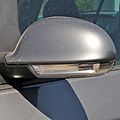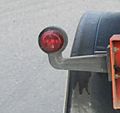Automotive lighting facts for kids
The lighting system on a car or other vehicle is super important! It includes all the lights and signals found on the front, back, sides, and sometimes even the top of a vehicle. These lights do a few main things:
- They light up the road so the driver can see where they're going, especially at night or when it's dark.
- They make the vehicle easy for others to see, which is really important in bad weather or low light.
- They tell other drivers and people walking nearby where the vehicle is and which way it's going.
- Special vehicles like ambulances or police cars have unique flashing lights to show they are coming quickly in an emergency.
How Car Lights Started
Cars have had lights for over a hundred years! Before cars, horse-drawn carriages used candles for light.
- The very first cars, sometimes called "horseless carriages," used gas lamps.
- By 1908, electric lights started to appear on vehicles.
- Red tail lights (at the back) and yellow brake lights (when you slow down) were used by 1915.
- Special "sealed beam" headlights, which were sealed units, came out in 1936.
- Turn signals, which tell others you're turning, became common by 1940.
- For a while, all cars in the U.S. had to use standard 7-inch round headlights.
- In 1956, cars could start having four headlights instead of just two.
- Newer, brighter halogen lights were first used on European cars in 1960 and came to the U.S. by 1979.
- Car light bulbs that you could easily replace started being used in the U.S. in 1983.
Types of Lights on a Car
Cars have many different kinds of lights, each with a special job:
- Headlights are at the front of the car and light up the road ahead. They are designed to help you see far, but without blinding drivers coming the other way. Drivers learn not to "overdrive their headlights," meaning they don't go so fast that they can't stop within the area their lights show.
- Tail lights are red lights at the back of the car. They turn on when the headlights are on. Most modern cars must have two tail lights.
- Stop lights (also called brake lights) are usually part of the tail light setup. They are brighter red lights that turn on when the driver presses the brake pedal, warning drivers behind you that you are slowing down or stopping.
- Marker lights are small lights on the sides of the car that help other drivers see the full size of your vehicle, especially at night.
- Turn signals are lights that flash to show which way a driver plans to turn or change lanes. They are usually amber (yellow-orange) and are found at the front, back, and sometimes the sides of the car.
- Third brake light. Since the 1980s and 1990s in many countries, cars have been required to have an extra brake light mounted higher up, usually in the middle of the back window. This light gives an even clearer warning to drivers behind you.
- Fog lights are optional on many cars. Regular headlights can reflect off fog and cause glare. Fog lights are aimed lower to help you see the road better in fog, heavy rain, snow, or dust. They also spread light out wider.
- Driving lights are extra lights designed to help headlights see even farther down the road. They shine a narrow, powerful beam much further than regular headlights.
Images for kids
See also
 In Spanish: Iluminación automotriz para niños
In Spanish: Iluminación automotriz para niños

All content from Kiddle encyclopedia articles (including the article images and facts) can be freely used under Attribution-ShareAlike license, unless stated otherwise. Cite this article:
Automotive lighting Facts for Kids. Kiddle Encyclopedia.























